1995 CHEVROLET S10 maintenance
[x] Cancel search: maintenancePage 2 of 354
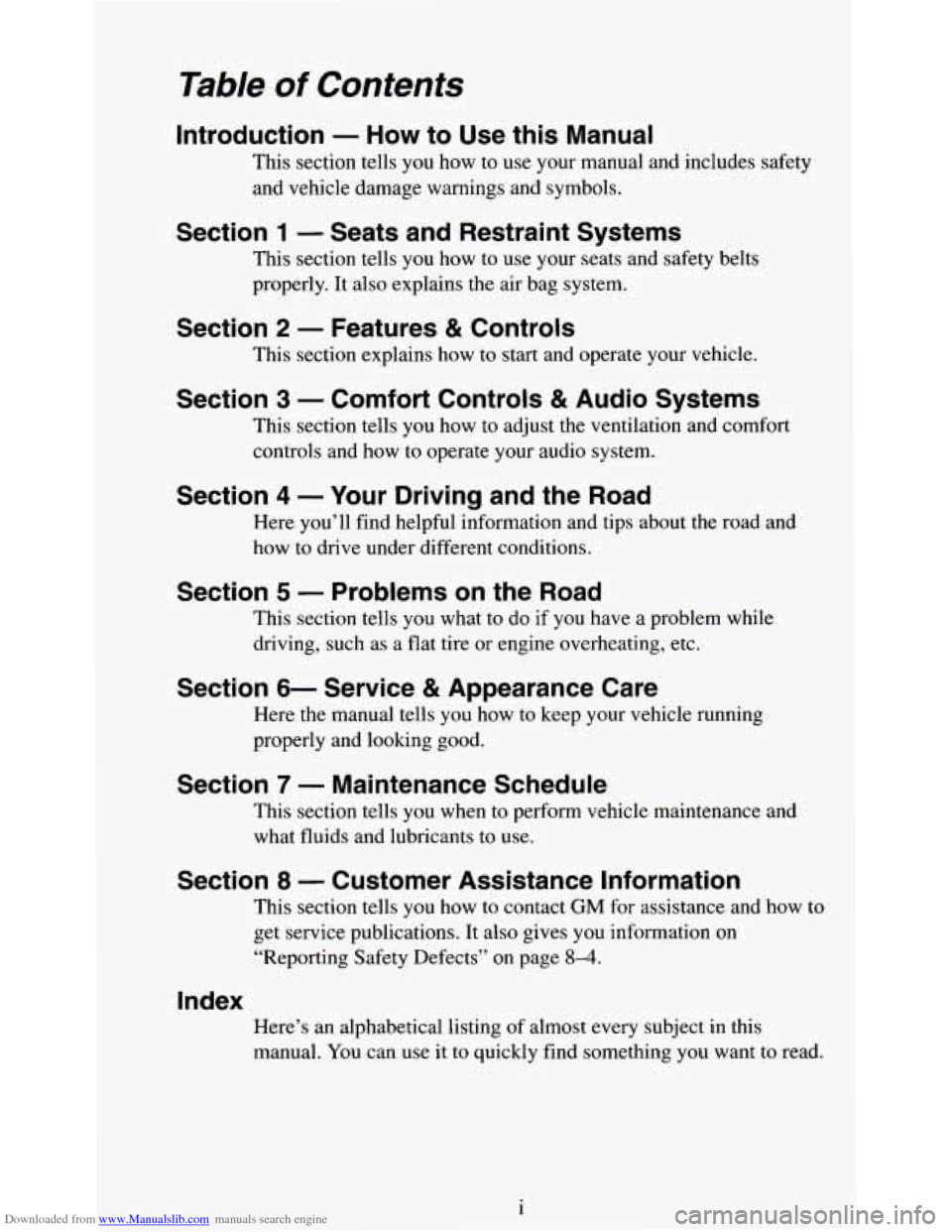
Downloaded from www.Manualslib.com manuals search engine Table of Contents
Introduction - How to Use this Manual
This section tells you how to use your manual and includes safety
and vehicle damage warnings and symbols.
Section 1 - Seats and Restraint Systems
This section tells you how to use your seats and safety belts
properly. It also explains the air bag system.
Section 2 - Features & Controls
This section explains how to start and operate your vehicle.
Section 3 - Comfort Controls & Audio Systems
This section tells you how to adjust the ventilation and comfort
controls and how to operate your audio system.
Section 4 - Your Driving and the Road
Here you’ll find helpful information and tips about the road and
how to drive under different conditions.
Section 5 - Problems on the Road
This section tells you what to do if you have a problem while
driving, such as a flat tire or engine overheating, etc.
Section 6- Service & Appearance Care
Here the manual tells you how to keep your vehicle running
properly and looking good.
Section 7 - Maintenance Schedule
This section tells you when to perform vehicle maintenance and
what fluids and lubricants to use.
Section 8 - Customer Assistance Information
This section tells you how to contact GM for assistance and how to
get service publications. It also gives you information on
“Reporting Safety Defects” on page
8-4.
Index
Here’s an alphabetical listing of almost every subject in this
manual. You can use it to quickly find something you want to read.
1
Page 3 of 354
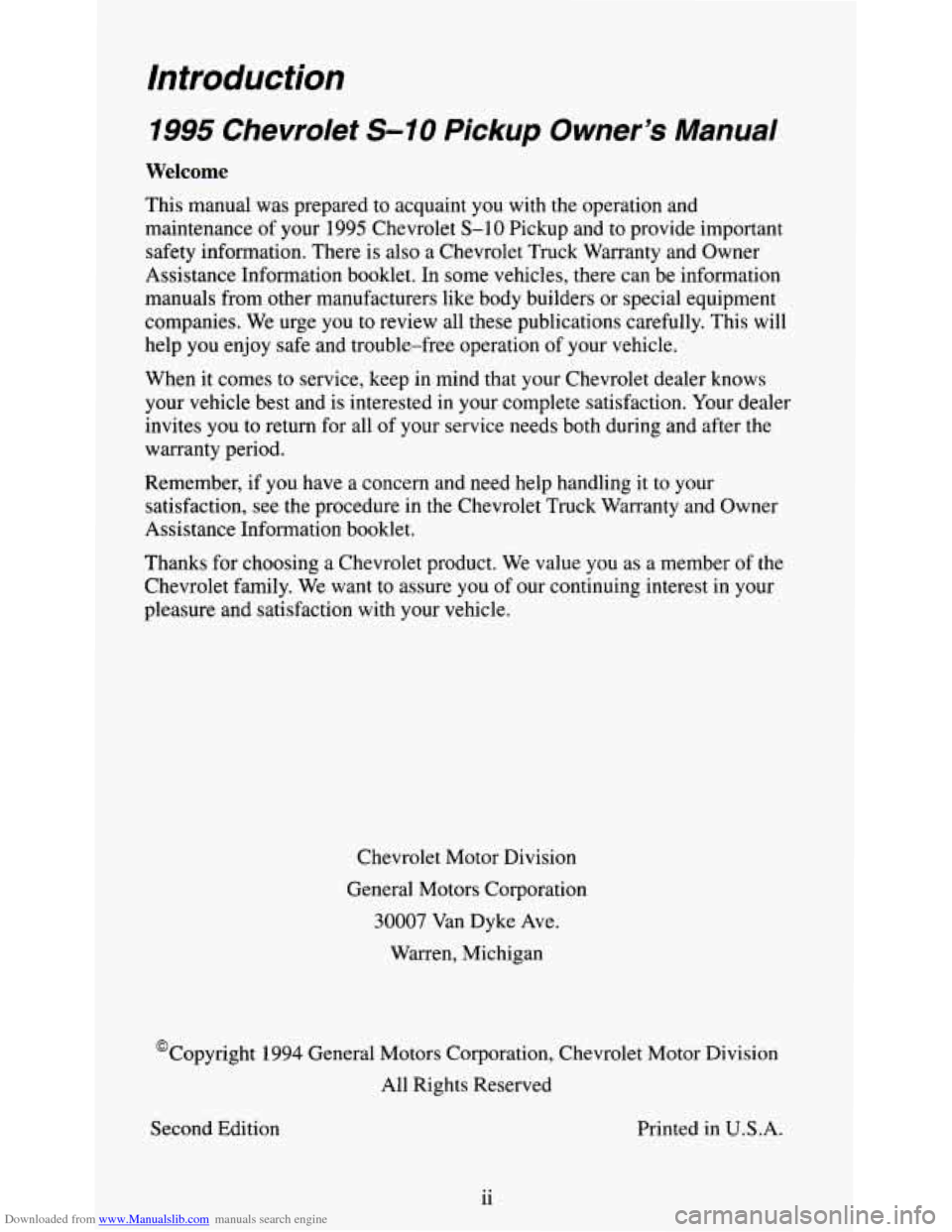
Downloaded from www.Manualslib.com manuals search engine Introduction
1995 Chevrolet S-IO Pickup Owner’s Manual
Welcome
This manual was prepared to acquaint you with the operation and
maintenance
of your 1995 Chevrolet S-1 0 Pickup and to provide important
safety information. There is also a Chevrolet Truck Warranty and Owner
Assistance Information booklet. In some vehicles, there can be information
manuals from other manufacturers like body builders or special equipment
companies.
We urge you to review all these publications carefully. This will
help you enjoy safe and trouble-free operation of your vehicle.
When it comes to service, keep in mind that your Chevrolet dealer knows
your vehicle best and is interested in your complete satisfaction. Your dealer
invites you to return for all
of your service needs both during and after the
warranty period.
Remember,
if you have a concern and need help handling it to your
satisfaction, see the procedure in the Chevrolet Truck Warranty and Owner
Assistance Information booklet.
Thanks for choosing a Chevrolet product. We value you as a member
of the
Chevrolet family. We want to assure you of our continuing interest in your
pleasure and satisfaction with your vehicle.
Chevrolet Motor Division
General Motors Corporation
30007 Van Dyke Ave.
Warren, Michigan
@Copyright
1994 General Motors Corporation, Chevrolet Motor Division
All Rights Reserved
Second Edition Printed
in U.S.A.
11 ..
Page 29 of 354

Downloaded from www.Manualslib.com manuals search engine Your vehicle is equipped with a diagnostic module, which records
information about the air bag system. The module records information
about the readiness
of the system, when the sensors are activated and
driver’s safety belt usage at deployment.
Let only qualified technicians work on your air bag system. Improper
service can mean that your air bag system won’t work properly. See
your dealer for service.
NOTICE:
If you damage the cover for the driver’s air bag, it may not work
properly. You may have to replace the air bag module.
Do not
open or break the air bag cover.
Servicing Your Air Bag-Equipped Vehicle
The air bag affects how your vehicle should be serviced. There are parts of
the air
bag system in several places around your vehicle. You don’t want the
system to inflate while someone is working
on your vehicle. Your GM
dealer and the
1995 GM Service Manual have information about servicing
your vehicle and the air bag system. To purchase a service manual, see
“Service Publications” in the Index. The air bag system does not need
regular maintenance.
I A CAUTION:
For up to 2 minutes after the ignition key is turned off and the
battery
is disconnected, an air bag can still inflate during
improper service. You can be injured
if you are close to an air
bag when,it inflates. Avoid wires wrapped with yellow tape, or
yellow connectors. They are probably part
of the air bag system.
Be sure to follow proper service procedures, and make sure the
person performing work for you is qualified to do
so.
1-20
Page 145 of 354
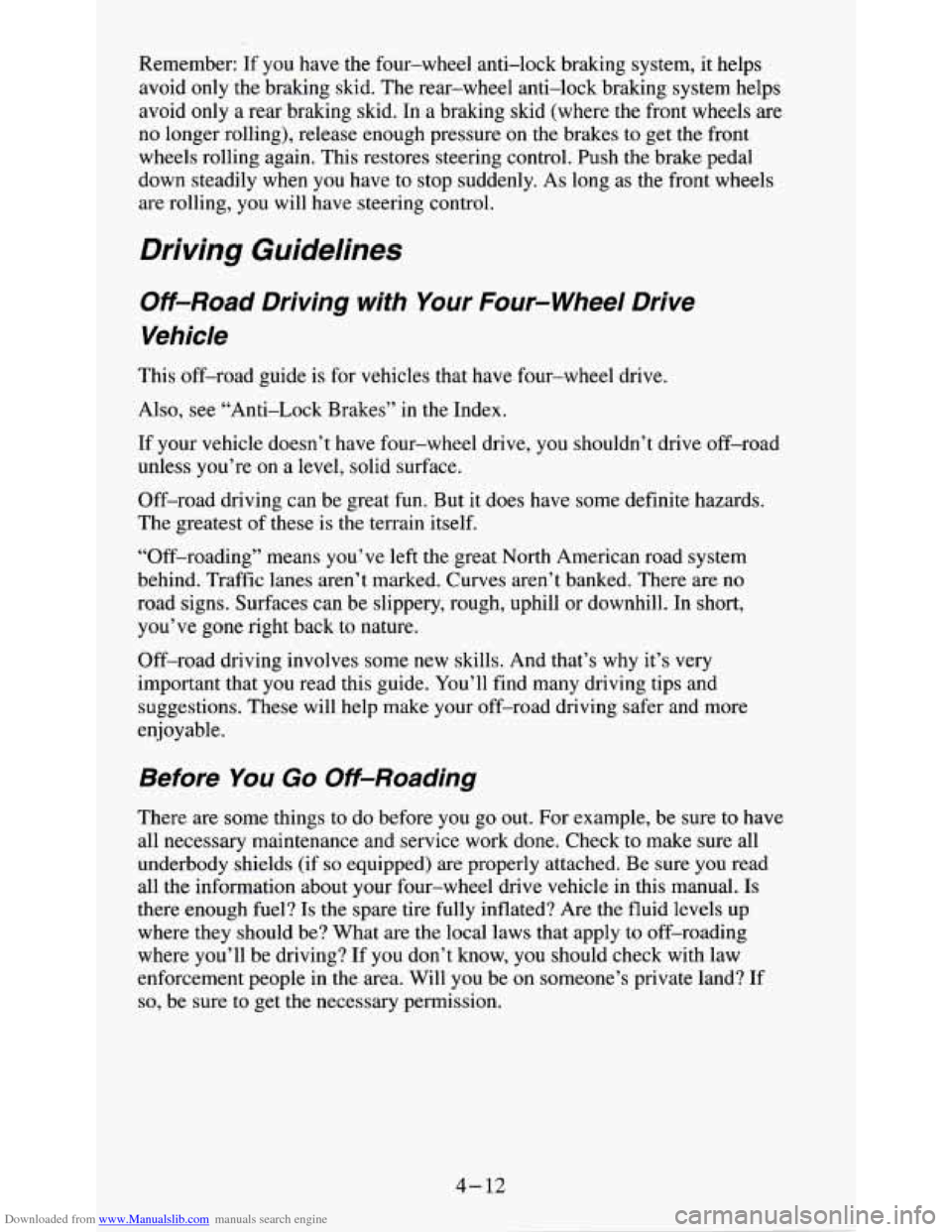
Downloaded from www.Manualslib.com manuals search engine Remember: If you have the four-wheel anti-lock braking system, it helps
avoid only the braking skid. The rear-wheel anti-lock braking system helps
avoid only a rear braking skid. In a braking skid (where the front wheels are
no longer rolling), release enough pressure
on the brakes to get the front
wheels rolling again. This restores steering control. Push the brake pedal
down steadily when you have to stop suddenly. As long as the front wheels
are rolling, you will have steering control.
Driving Guidelines
OR-Road Driving with Your Four-wheel Drive
Vehicle
This off-road guide is for vehicles that have four-wheel drive.
Also, see “Anti-Lock Brakes” in the Index.
If your vehicle doesn’t have four-wheel drive, you shouldn’t drive off-road
unless you’re on a level, solid surface.
Off-road driving can be great fun. But it does have some definite hazards.
The greatest of these is the terrain itself.
“Off-roading” means you’ve left the great North American road system
behind. Traffic lanes aren’t marked. Curves aren’t banked. There are no
road signs. Surfaces can be slippery, rough, uphill or downhill. In short,
you’ve gone right back to nature.
Off-road driving involves some new skills. And that’s why it’s very
important that
you read this guide. You’ll find many driving tips and
suggestions. These will help make your off-road driving safer and more
enjoyable.
Before You Go Off-Roading
There are some things to do before you go out. For example, be sure to have
all necessary maintenance and service work done. Check to make sure all
underbody shields (if
so equipped) are properly attached. Be sure you read
all the information about your four-wheel drive vehicle
in this manual. Is
there enough fuel? Is the spare tire fully inflated? Are the fluid levels up
where they should be? What are the local laws that apply to off-roading
where you’ll be driving? If you don’t know, you should check with law
enforcement people in the area. Will you be
on someone’s private land? If
so, be sure to get the necessary permission.
4- 12
Page 156 of 354

Downloaded from www.Manualslib.com manuals search engine Driving through rushing water can be dangerous. Deep water can sweep your vehicle downstream and you and your
passengers
could drown. If it’s only inches deep, it can still wash
away the ground from under your tires, and you could lose
traction and roll the vehicle over. Ron’t drive through rush\
ing water.
After Off-Road Driving
Remove any brush or debris that has collected on the underbody, chassis or
under the hood. These accumulations can be a fire hazard.
After operation in mud
or sand, have the brake linings cleaned and checked.
These substances can cause glazing and uneven braking. Check the body
structure, steering, suspension, wheels, tires, and exhaust system for
damage. Also, check the fuel lines and cooling system for any leakage.
Your vehicle will require more frequent service due to off-road
use. Refer
to the Maintenance Schedule for additional information.
Driving at Night
Night driving is more dangerous than day driving. One reason is that some
drivers
are likely to be impaired - by alcohol or drugs, with night vision
problems, or by fatigue.
4-23
Page 182 of 354

Downloaded from www.Manualslib.com manuals search engine When You Are Ready to Leave After Parking on a Hill
1. Apply your regular brakes and hold the pedal down while you:
Start your engine;
Shift into a gear; and
Release the parking brake.
2. Let up on the brake pedal.
3. Drive slowly until the trailer is clear of the chocks.
4. Stop and have someone pick up and store the chocks.
Maintenance When Trailer Towing
Your vehicle will need service more often when you’re pulling a trailer. See
the Maintenance Schedule for more on this. Things that are especially
important in trailer operation are automatic transmission fluid (don’t
overfill), engine oil, axle lubricant, belt, cooling system, and brake
adjustment. Each of these is covered in this manual, and the Index will help
you find them quickly. If you’re trailering, it’s a
good idea to review these
sections before you start your trip.
Check periodically to
see that all hitch nuts and bolts are tight.
Trailer Lighting Systems Wiring
See “Trailer Wiring Harness” in the Index.
4-49
Page 219 of 354
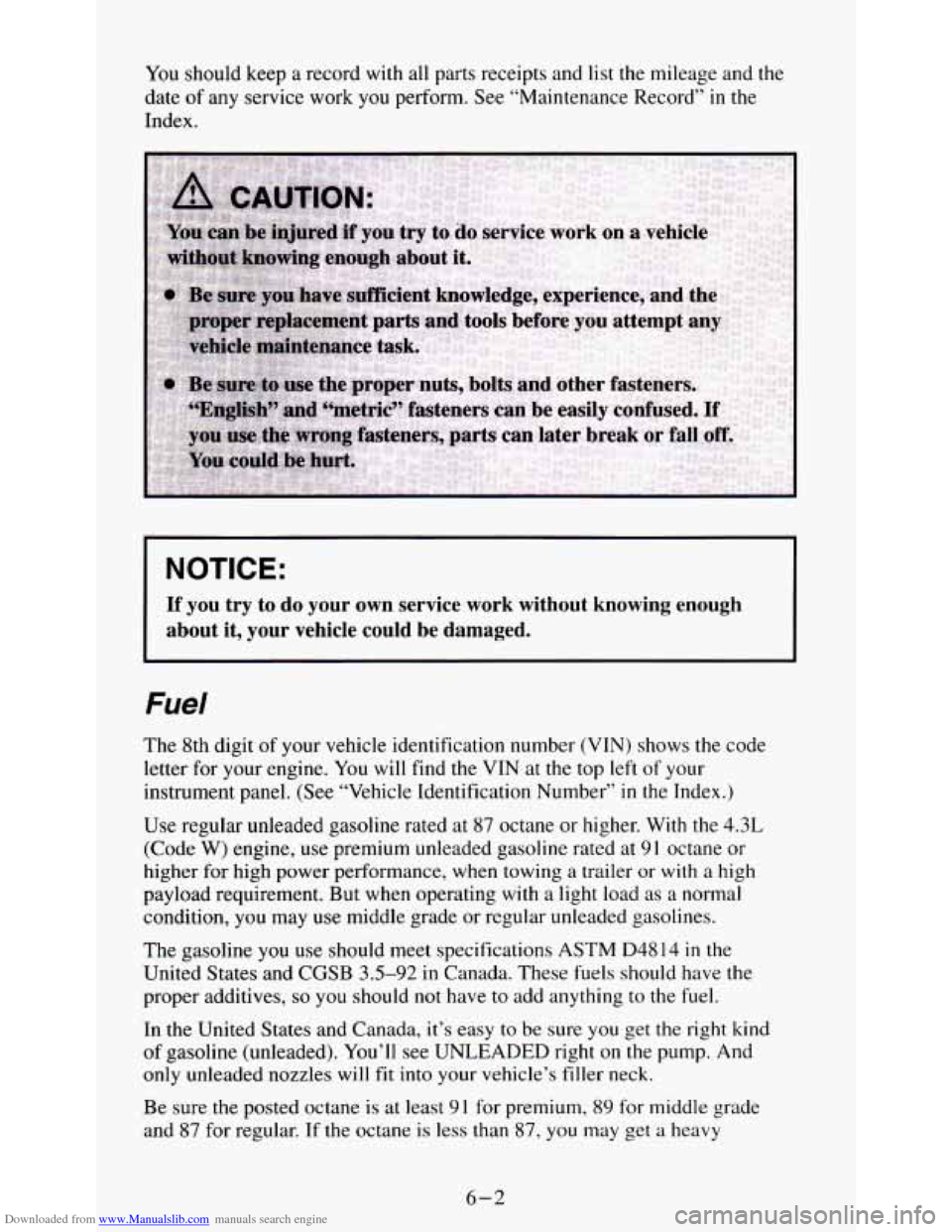
Downloaded from www.Manualslib.com manuals search engine You should keep a record with all parts receipts and list the mileage and the
date
of any service work you perform. See “Maintenance Record” in the
Index.
NOTICE:
If you try to do your own service work without knowing enough
about it, your vehicle could be damaged.
Fuel
The 8th digit of your vehicle identification number (VIN) shows the code
letter for your engine. You will find the VIN at the top left
of your
instrument panel. (See “Vehicle Identification Number”
in the Index.)
Use regular unleaded gasoline rated at 87 octane or higher. With the
4.3L
(Code W) engine, use premium unleaded gasoline rated at 9 1 octane or
higher for high power performance, when towing
a trailer or with a high
payload requirement. But when operating with a light load
as a normal
condition, you may use middle grade or regular unleaded gasolines.
The gasoline you use should meet specifications
ASTM D48 14 in the
United States and CGSB
3.5-92 in Canada. These fuels should have the
proper additives,
so you should not have to add anything to the fuel.
In the United States and Canada, it’s easy to be sure you get the right kind
of gasoline (unleaded). You’ll see UNLEADED right on the pump. And
only unleaded nozzles will fit into your vehicle’s filler neck.
Be sure the posted octane
is at least 91 for premium, 89 for middle grade
and 87 for regular. If the octane
is less than 87, you may get a heavy
6-2
Page 230 of 354
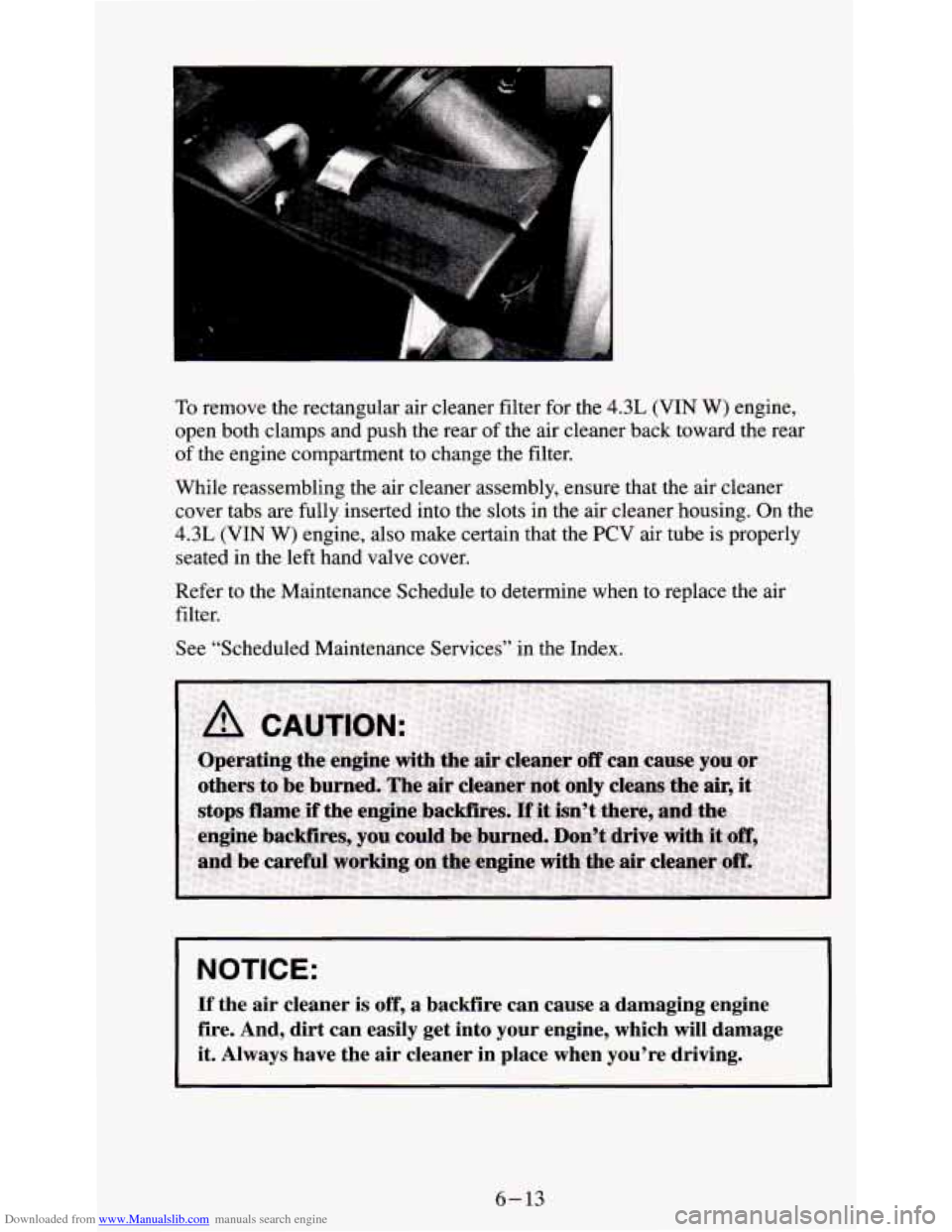
Downloaded from www.Manualslib.com manuals search engine To remove the rectangular air cleaner filter for the 4.3L (VIN W) engine,
open both clamps and push the rear of the air cleaner back toward the rear
of the engine compartment to change the filter.
While reassembling the air cleaner assembly, ensure that the air cleaner
cover tabs are fully inserted into the slots in the air cleaner housing. On the
4.3L (VIN W) engine, also make certain that the PCV air tube is properly
seated in the left hand valve cover.
Refer to the Maintenance Schedule to determine when to replace the air
filter.
See “Scheduled Maintenance Services’’ in the Index.
I NOTICE:
If the air cleaner is off, a backfire can cause a damaging engine
fire. And, dirt can easily get into your engine, which
will damage
it. Always have the air cleaner in place when you’re drivin\
g.
6- 13